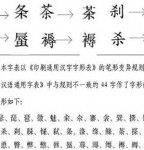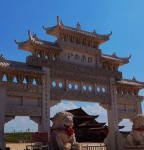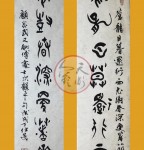1. Laozi and Lao Tan in Early Sources
Zhuangzi gives the following, probably fictional, account of Confucius‘s impression of Laozi:
“Master, you’ve seen Lao Tan—what estimation would you make of him?” Confucius said, “At last I may say that I have seen a dragon—a dragon that coils to show his body at its best, that sprawls out to display his patterns at their best, riding on the breath of the clouds, feeding on the yin and yang. My mouth feel open and I couldn’t close it; my tongue flew up and I couldn’t even stammer. How could I possibly make any estimation of Lao Tan!” Zhuangzi, Ch. 14According to The Book of Rites (Li ji), a master known as Lao Tan was an expert on mourning rituals. On four occasions, Confucius (kongzi, Master Kong) is reported to have responded to questions by appealing to answers given by Lao Tan. The records say that Confucius once assisted him in a burial service.
In the Zhuangzi (late 4th century BCE), Lao Tan is usually a critic of Confucius. This is the first text to use Laozi as a personal name and to identify Laozi and Lao tan. The Zhuangzi contains materials from a teacher known as Zhuang Zhou who lived between 370-300 BCE, according to Sima Qian. Chapters 1-7 of the present 33 are those most often ascribed to Zhuangzi (meaning Master Zhuang). Guo Xiang edited the text in the first half of the 3rd Cent. CE. He had 52 sections handed down to him. He rejected the material he thought was inferior and spurious, keeping 33 chapters which he divided into the “inner chapters” (chs. 1-7), “outer chapters” (chs. 8-22) and “mixed chapters,” (chs. 23-33). Aside from chs. 1-7, the remaining 26 had origins other than Zhuang Zhou and they sometimes take different points of view. In the citations below, I have followed the practice of prefacing the chapter with its literary critical designation (that is, inner, outer, mixed). These designations are oversimplified textually and arguable, but at least some acknowledgment of where they are located in this textual system may help one understand that some of the passages come from different time periods and have specific polemical agendas.
Assuming that Lao Tan and Laozi are the same figure and counting the one dialogue in Mixed Ch. 27 attributed to Lao Laizi as Laozi, then there are eighteen (18) passages in which Laozi plays a role in the Zhuangzi. It is on the basis on Inner Chapter 3, The Secret of Caring for Life that we identify Lao Tan and Laozi. The passage begins “When Lao Tan died” but then when his disciple Ch’in Shih is attacked by his fellow students for only making three cries and then leaving the funeral hall, the text calls them “Laozi’s disciples.” Ch’in Shih’s defense is “Your master happened to come because it was his time, and he happened to leave because things follow along. If you are content with the time and willing to follow along, then grief and joy have no way to enter.” His association of the dead master with the students who are Laozi’s disciples, and the opening of the chapter makes the identification of Lao Tan and Laozi pretty clear. Then, there are dialogues in which Lao Tan and Laozi are used interchangeably (see Outer Ch.14, Turning of Heaven and Mixed Ch. 27, Imputed Words). Other biographically significant material includes a reference to Laozi’s being the keeper of the Royal Archives of the house of Zhou in Outer Ch. 13, The Way of Heaven.
Laozi’s relationship to Confucius is also a major part of the Zhuangzi‘s picture of the philosopher. Of the eighteen passages mentioning Laozi, Confucius figures as a dialogical partner or subject in nine (9). While it is clear that Confucius is thought to have a long way to go to become a zhen ren (the Zhuangzi‘s way of speaking about the true man), Lao Tan seems to feel sorry for Confucius in his reply to “No-Toes” in Inner Chapter 5, The Sign of Virtue Complete. He recommends seeking to release Confucius from the fetters of his tendency to make rules and human discriminations (e.g., right/wrong; beautiful/ugly).
Lao Tan addresses Confucius by his personal name “Ch’iu” in three passages. Since such a liberty is one that only a person with seniority and authority would take, this style invites us to believe that Confucius was a student of Lao Tan’s and acknowledged him as an authority. However, continuing the theme that Laozi taught Confucius, who was confused and having no success, we should note that the point of the story that mentions Laozi’s occupation as an archivist is that Confucius’ writings, offered to Laozi by Confucius himself, are simply not worthy to be put into the library. And on another occasion, Confucius claims that he knows the “six classics” thoroughly and that he has tried to persuade 72 kings to their truth, but they have been unmoved. Laozi’s reply is, “Good!” He tells Confucius not to occupy himself with such worn out ways, and to live the dao himself (Outer Ch.14, Turning of Heaven).
Another important set of exchanges occurs between Laozi and Confucius over the latter’s principal ideas of benevolence (ren) and righteousness (yi). Laozi tells Confucius to forget this teaching and be natural: “Why these flags of benevolence and righteousness so bravely upraised, as though you were beating a drum and searching for a lost child? Ah, you will bring confusion to the nature of man!” (Outer Ch. 13, The Way of Heaven)
Finally, in Outer Ch.14, Turning of Heaven, Lao Tan makes a direct attack not only on the rules and regulations of Confucius, but also the teachings of the Mohists, and the veneration of the ancient emperors and legendary sages of the past.
| < Prev | Next > |
|---|
- 2011-05-04 - Wang Xizhi, The Sage of Chinese Calligraphy
- 2011-04-23 - Ouyang Xun, one of the Four Great Calligraphers of Early Tang Dynasty
- 2011-04-07 - Chu Suiliang 褚遂良, one of the Four Great Calligraphers of Early Tang Dynasty
- 2011-01-07 - 文徵明行书《明妃曲》
- 2010-12-20 - Philosophy About Chinese Calligraphy
- 2010-08-08 - The Dragon's Embrace - China's Soft Power Is a Threat to the West
- 2010-06-04 - Aesthetics & Philosophy About Chinese Calligraphy
- 2010-04-19 - The Core of Chinese Culture
- 2010-03-12 - Bringing it All Back Home: Chu Teh-Chun at NAMOC













